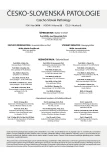Benefits of otoscopy in forensic autopsy practice: A prospective study
Authors:
Štěpánka Kučerová 1; Petr Hejna 1; Martin Dobiáš 2
Authors‘ workplace:
Ústav soudního lékařství LF UK a FN Hradec Králové
1; Ústav soudního lékařství a medicínského práva LF UP a FN Olomouc
2
Published in:
Soud Lék., 61, 2016, No. 2, p. 14-17
Category:
Original Article
Overview
The otoscopy is an examination of the external auditory canal, the eardrum, and the middle ear with an instrument called an otoscope. It is a simple, inexpensive, and time-saving endoscopic method typically used by general practitioners and otorhinolaryngologists. Authors present a prospective study of otoscopic findings investigated consecutively at autopsy. Of the 250 examined persons, 50 positive findings were identified: 38 cases with petechial hemorrhages and 12 cases with tympanic membrane perforation or hemotympanon. Hemorrhages of the tympanic membrane detected through the otoscopy may serve as evidence of congestion within head and neck potentially associated with asphyxiation either in the death or in the living (similar to periorbital and conjuctival petechial hemorrhages). In our study, hemorrhages of the tympanic membrane were related to heart failure, hanging and asphyxiation. Perforated tympanic membrane and hemotympanum have been sporadically reported in victims of fatal lightning strike and rarely in strangulation. This findings were in our study associated with craniocerebral injuries: traffic accidents, falls from height and gunshot injuries. The otoscopy may help to reveal various traumatic and pathological changes within the outer and the middle ear, and, thus, provide important forensic evidence. The otoscopy is also highly recommended in the investigation of the sudden deaths in the young.
Keywords:
endoscopy – otoscopy – forensic medicine – autopsy – the eardrum – petechial hemorrhage
Sources
1. Navrátil L, Rosina J, et al. Medicínská biofyzika. 1. vydání. Praha: Grada; 2005 : 524.
2. Šlapák I, et al. Dětská otorinolaryngologie. Praha: Mladá fronta; 2013 : 30-31.
3. Rasmussen ER, Larsen PL, Andersen K, Larsen M, Qvortrup K, Hougen HP. Petechial hemorrhages of the tympanic membrane in attempted suicide by hanging: A case report. J Forensic Leg Med 2013; 20(2): 119-121.
4. Sinkkonen ST, Jero J, Aarnisalo AA. Tympanic membrane perforation. Duodecim 2014; 130(8): 810-818.
5. Blumenthal R, Jandrell IR, West NJ. Does a sixth mechanism exist to explain lightning injuries?: investigating a possible new injury mechanism to determine the cause of injuries related to close lightning flashes. Am J Forensic Med Pathol 2012; 33(3): 222-226.
6. Gordon MA, Silverstein H, Willcox TO, Rosenberg SI. Lightning injury of the tympanic membrane. Am J Otol 1995; 16(3): 373-376.
7. Jones DT, Ogren FP, Roh LH, Moore GF. Lightning and its effects on the auditory system. Laryngoscope 1991; 101 : 830-834.
8. Bergstrom L, Neblett LW, Sando I, Hemenway WG, Harrison GD. The lightning damaged ear. Arch Otolaryngol 1974; 100(2): 117-121.
9. Gluncić I, Roje Z, Gluncić V, Poljak K. Ear Injury Caused by lightning: Report of 18 Cases. J Laryngol Otol 2001; 115(1): 4-8.
10. Wetli CV. Keraunopathology. An analysis of 45 fatalities. Am J Forensic Med Pathol 1996; 17(2): 89-98.
11. Kristensen S, Tveteras K. Lightning-induced acoustic rupture of the tympanic membrane: a report of two cases. J Laryngol Otol 1985; 99(7): 711-713.
12. Duband S, Timoshenko AP, Morrison AL, Prades JM, Debout M, Peoc’h M. Ear bleeding: A sign not to be underestimated in cases of strangulation. Am J Forensic Med Pathol 2009; 30(2): 175-176.
13. Nečas P, Hejna P. Eponymické termíny v soudním lékařství. Soud Lek 2012; 57(2): 25-30.
14. Jarrett A. Reversed-ear syndrome and the mechanism of barotrauma. Br Med J 1961; 19 : 483-486.
15. Shields LB, Corey TS, Weakley-Jones B, Steward D. Living victims of strangulation: a 10-year review of cases in a metropolitan community. Am J Forensic Med Pathol 2010; 31 : 320-325.
16. Xydakis MS, Bebarta VS, Harrison CD, Conner JC, Grant GA, Robbins AS. Tympanic-membrane perforation as a marker of concussive brain injury in Iraq. N Engl J Med 2007; 23; 357(8): 830-831.
17. Hashimoto Y, Furumiya J. Otitis media observed in unexpected natural death of infants. Leg Med (Tokyo) 2009; 11 Suppl 1 : 121-123.
18. Ehrhardt, G. About correlation between sudden unexpected death and otitis media occulta in infancy and childhood. Zentralbl Allg Pathol 1975; 119 : 91–99.
Labels
Anatomical pathology Forensic medical examiner ToxicologyArticle was published in
Forensic Medicine

2016 Issue 2
Most read in this issue
- Injury of upper cervical spine
- Benefits of otoscopy in forensic autopsy practice: A prospective study
- Right haemothorax related to the rupture of abdominal aortic aneurysm
